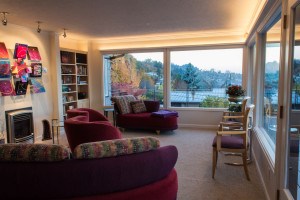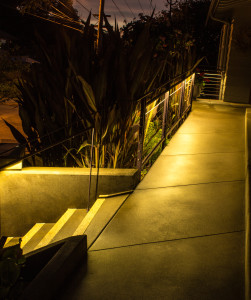Home Lighting
 The fastest-growing demographic group in America is people aged 65 or older. The U.S. Department of Health and Human Services projects that by 2030, this group will grow to more than 72 million people, or 19% of the population. As the aging adult population continues to increase, the role lighting plays in meeting their needs becomes increasingly more important.
The fastest-growing demographic group in America is people aged 65 or older. The U.S. Department of Health and Human Services projects that by 2030, this group will grow to more than 72 million people, or 19% of the population. As the aging adult population continues to increase, the role lighting plays in meeting their needs becomes increasingly more important.
We asked designer Eunice Noell-Waggoner, President of the Center of Design for an Aging Society, to share her insights on lighting for seniors.
Q:Why is it important to re-evaluate the lighting in our homes as we get older?
A: It is often said that the “quality of light in an older person’s home has a direct impact on their quality of life.” In a recent poll, 84% of seniors said they wished to stay in their own homes rather than move to a new home or a retirement center. Loss of independence is the greatest fear of aging. Providing quality lighting within the home will maximize vision and promote independence as people age in place, and equally important, will also help keep them safe.
Q:What changes to the eye occur as we age that make it harder to see?
A: Everyone will experience the normal age-related changes to their vision. Eye diseases also increase as people age. The normal changes occur all along the visual pathway from the pupil to the retina to the brain. These changes require that both “quantity” and “quality” of light be addressed:
- Higher levels of light are needed for good vision: Light reaching the retina is reduced to 33% at age 65, and 20% at age 85 (approximately), as compared to young people.
- Increased sensitivity to glare is caused by light scatter within the eye.
- Longer adaptation time is required, especially from bright to dim.
- Loss of contrast sensitivity limits independence. The combination of lighting and contrast in the visual environment will help to minimize the effect.
Q:Glare is obviously a big concern for seniors. What considerations should we make with regard to glare?
A:Direct and reflected glare impact seniors, requiring that both lighting and surface finishes are carefully selected:
Direct glare. To control direct glare from ambient lighting, the light source must be concealed or diffused. To control direct glare from sunlight, woven shades should be used to diffuse the light. The ability to adjust the position and/or direction of a task light is the best assurance that the user will be able to mitigate the direct glare or veiling reflections.
Reflected glare. Polished surfaces directly reflect the light, whereas matte finishes diffuse the light in all directions. For example, polished floors and glass-top tables are problematic. Bright sunlight reflecting on a polished floor may result in disability glare and hinder mobility.
Ambient lighting. Indirect or direct/indirect lighting systems provide the necessary higher light levels without glare. They also light the spatial volume with even and consistent light levels, eliminating the need for the aging eyes to adapt to changes in brightness. How much is enough light? That will depend upon the needs of everyone in the home. What is right for one member of the household may not be right for another. Providing layers of light with easy-to-use controls (large-button slide dimmers) will allow each person to make adjustments to meet their personal needs.
Task lighting. In the home, task lighting includes all activities of daily living, not just reading. These include visual tasks that may not be challenging for younger people, but require quality lighting as defined above as well as high color rendering light sources. The aging lens thickens and turns a slight amber color, making color discrimination (e.g., matching of clothes) more challenging. Finding and treating stains on clothing is an example of a task that is important for self-esteem and self-confidence.
Safety concerns. Fall prevention is a major health issue for older adults. Lighting within a shower or tub enclosure, on stair treads, and nightlights will help to prevent falls. Adequate ambient light in all areas of circulation and living spaces will also promote safety by allowing the user to avoid potential obstacles in their pathway.
Q:Are there simple modifications we can do in our homes as we age, or does this require an entire lighting overhaul?
 A: Adding or changing task lighting will be the easiest to do since, in most cases, the electrical wiring has been provided. Adding ambient light to living rooms or bedrooms may be the most difficult, if these rooms currently rely on switched outlets for floor and table lamps. It is possible to utilize the existing controls and extend the wiring from a switched outlet to supply a new light valance that will provide indirect ambient light to the ceiling.
A: Adding or changing task lighting will be the easiest to do since, in most cases, the electrical wiring has been provided. Adding ambient light to living rooms or bedrooms may be the most difficult, if these rooms currently rely on switched outlets for floor and table lamps. It is possible to utilize the existing controls and extend the wiring from a switched outlet to supply a new light valance that will provide indirect ambient light to the ceiling.
Q:What areas on the exterior of our homes should we pay special attention to?
 A: Steps, changes of level, and obstacles in the pathway must all be lighted at night. Porch lighting should be positioned to illuminate the house numbers, keyhole, and faces of visitors. Backlit house numbers with strong contrast will be visible day and night. A permanent value contrast on the edge of the step increases the visibility of the tread at all times.
A: Steps, changes of level, and obstacles in the pathway must all be lighted at night. Porch lighting should be positioned to illuminate the house numbers, keyhole, and faces of visitors. Backlit house numbers with strong contrast will be visible day and night. A permanent value contrast on the edge of the step increases the visibility of the tread at all times.
Q:What about the lighting in our living spaces?
A: Kitchens. Lighting the countertops and cooking surfaces, including controls, may be obvious, but lighting the contents of upper and lower cabinets and drawers is also important. Since some medications must be taken with meals, seniors may store specific medications in the kitchen, requiring adequate light to read the labels and distinguish colors.
Bathrooms. Bathrooms must be lighted differently for use during the day and night. During the day the primary focus is safety, thereby providing adequate light for bathing, using the toilet, and grooming activities. Vanity luminaires should be placed vertically on both sides of the mirror in order to light both sides of the face and under the nose and chin. Nightlights, which direct the light to the floor, are needed to light the pathway between the bed and bathroom and the toilet area. The color should be limited to amber (or red) to avoid disrupting the resident’s circadian rhythm.
Living, dining, and general activity areas. By providing layers of light, these spaces can be well lit without looking commercial or too bright. The combination of indirect ambient light along with table or floor lamps, wall sconces, wall-wash luminaires, accent lighting, and chandeliers will provide a well-balanced lighting design.
Q:Are there certain fixtures/sources that are better than others for the aging eye?
A: Daylight. Daylighting within the home is very important for vision as well as establishing healthy circadian rhythms. Daylight needs to be balanced within the space by providing daylight from more than one direction or daylight devices to redirect a portion of the light to the ceiling. Many seniors use the direct sunlight for difficult visual tasks, such as mending or puzzles where very high light levels are required.
Sunlight exposure. It has been demonstrated that seniors with reduced mobility have less daylight exposure. Providing easy access to the outdoors to promote brief periods of sunlight exposure can be very beneficial. Sunlight exposure on the skin synthesizes Vitamin D3 and is important to absorb calcium for bone, muscle, and brain health.
Fluorescent tubes. Long fluorescent tubes are still viable for vanities, valances, coffers, indirect over-cabinet lighting, or wherever a linear light source is required.
LED. LEDs are quickly replacing incandescent and compact fluorescent light sources, whether they are used as a replacement lamp or in luminaires, which are designed specifically as LED fixtures. LED and long tube fluorescent luminaires may be used for the same applications. In my experience, the LEDs are currently about twice as expensive as a fluorescent installation.
However the LED luminaire is much smaller and may use less energy than the high-performance fluorescent tubes. One distinct feature of special LED luminaires is the ability to adjust the color temperature for day and night use. As more of the color-tuning LEDs come on the market, I would expect that they would be used for homebound seniors, as well as in general lighting for the aging population. Everyone’s eyes have different needs, so the color tuning may benefit vision as well establish healthy circadian rhythms.
Eunice Noell-Waggoner spent the first half of her professional career as an interior and lighting designer for public buildings and commercial spaces. She became concerned about the environmental needs of the end users, especially older people. The second half of her career has been focused on addressing these needs through the Center of Design for an Aging Society, a not-for-profit organization she founded dedicated to improving homes, public buildings, and public outdoor spaces to support dignity, independence, health, and safety of our aging population. She also directed the development of the first edition of ANSI/IES RP-28 “Lighting and the Visual Environment for Senior Living.”